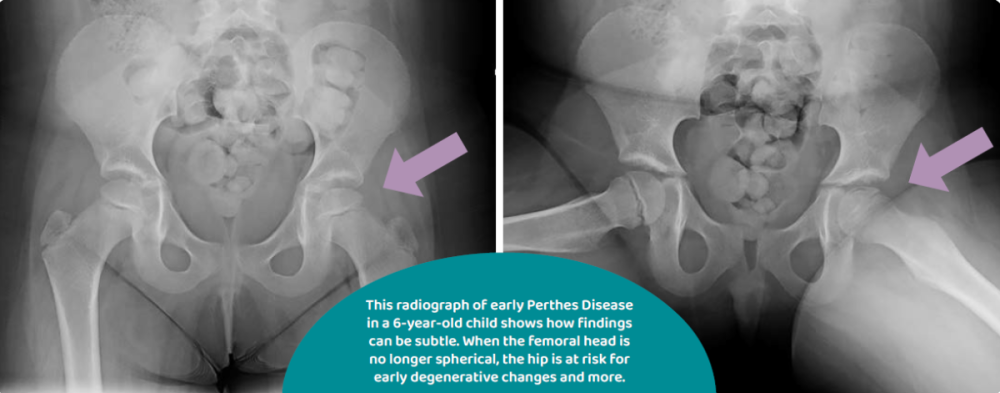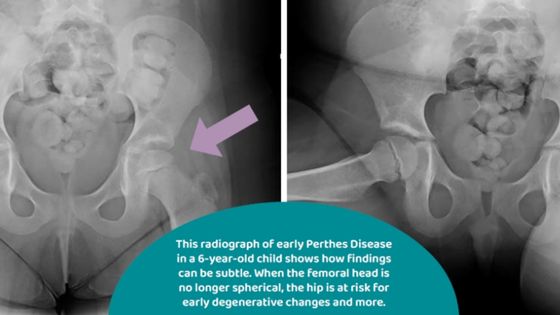What Is Perthes?

This radiograph of early Perthes Disease in a 6-year-old child shows how findings can be subtle. Then the femoral head is no longer spherical, the hip is at risk for early degenerative changes and more.
Perthes is a painful pediatric hip disorder of unknown etiology. Perthes involves idiopathic disruption of the blood supply to the growing femoral head. This disruption includes phases of ischemic injury (avascular necrosis) and its repair (revascularization, bone resorption, and eventual new bone formation). The overall healing process for the femoral head can take three to five years. During the active stages of bone resorption and new bone formation, the femoral head becomes relatively weak and susceptible to deformation, including flattening/collapse.
The hip functions best as a congruent ball-and-socket joint. When the femoral head is no longer spherical, the hip is at risk for early degenerative changes and osteoarthritis. Additionally, children with Perthes are at risk for hip impingement, limp, leg length discrepancy, and chronic pain.
Dr. Laine says, “Even with intervention, one-third of patients develop a permanently flattened femoral head when the healing process is complete. Additionally, because of the incongruence of the hip joint, approximately 60% of patients with a deformed femoral head progress to moderate or severe osteoarthritis within 20 years of their Perthes diagnosis.”
Recognizing Perthes in Clinic
Though Perthes is considered a rare disease, affecting 1 in 740 boys and 1 in 3,500 girls under the age of 15, you may encounter it in the clinic. Recognizing the warning signs of Perthes can help your patient get a diagnosis and care plan as early as possible.
- Tip No. 1: The age range for Perthes diagnosis is typically 4–9 years, although it can be seen in children as young as 18 months and as old as 14 years.
- Tip No. 2: Typically, Perthes has an insidious onset with a limp and hip, groin, thigh, or knee pain. Families often attribute the intermittent limp and discomfort to the child’s active lifestyle, which can lead to a delay in presentation. Referred pain in the knee or thigh can also lead to a delay in diagnosis.
- Tip No. 3: It is important to remember to image the hip when a child has vague thigh or knee pain. Perthes is typically diagnosed on AP and frog lateral X-ray imaging of the pelvis.
Dr. Laine says early diagnosis in Perthes is critical to initiate early treatment and support the patient and their family. “We are finding that Perthes disease has a significant impact on physical, mental, and social health in childhood and adulthood. While we need better approaches to improving hip outcomes, it is also essential that we treat the child as a whole, understanding the overall impact of Perthes and its treatments.”
Dr. Laine sees Perthes patients in a dedicated clinic twice per month. To refer a patient, visit our referral page or call 651-325-2200.
Join Our Partners in Care Community!
Subscribe to Partners in Care Journal, a newsletter for medical professionals.
Subscribe Today Home Page
Home Page

